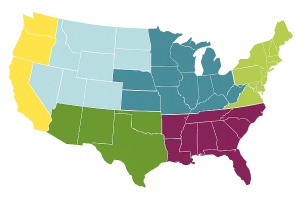Garden Styles Explained
Posted By American Meadows Content Team on Mar 24, 2017 · Revised on Oct 3, 2025

Knowing your location helps us recommend plants that will thrive in your climate, based on your Growing Zone.
Posted By American Meadows Content Team on Mar 24, 2017 · Revised on Oct 3, 2025
Imagine a luxurious chateau in France surrounded by symmetrical evergreen borders and vast expanses of lawn with a fountain focal point in the center. Now move your mind to Japan, where you can walk through a serene mossy-green forest garden, with a soft bubbling stream running through. Lastly, travel your mind to England, and picture being immersed in the bright colorful blooms surrounding a quaint cottage. If you managed to transport your mind to these spaces, you already intuitively know major garden styles and where they came from!


Gardening styles have evolved throughout history, from trends in different locations around the world. They have developed and cycled as fashion trends do. Today, we can imagine and become exposed to all different types of gardens. Through that opportunity, we can mix, match, and blend aspects of gardening styles to create endless selections. Let’s talk in more detail about the major gardening styles: where they come from, and what elements make them what they are.
The formal garden style historically is traced back to 16th century France. The French formal design has many repetitive elements that create an overall look of axial symmetry, focal points, and topiaries. It is not abundant in color, being dominated with green horizontal space of lawn balanced by green vertical space of tree and shrub topiary. While the most famous landscapes, such as the Palace of Versailles, express this garden style in vast expanse, it is possible to borrow elements of the formal garden design to incorporate into your own garden. The most common elements of a formal garden include:


The cottage garden style originated from 18th century England. Out of necessity, peasants would plant gardens around their home consisting mostly of vegetables and plants for medicine and dyes, interspersed with a few ornamental flowers. The gardens contained everything of importance for the survival of the peasants, including beehives and livestock. This created an atmosphere that utilized every available space, being crammed with plants yet well-tended. The use of fences was incorporated to keep livestock away from the plants.

The style of garden was noticed by the British leisurely class and become more idealized. The cottage garden spread with popularity using more and more colorful ornamentals rather than vegetables and getting farther away from the necessity with which the gardens originated. They continued to utilize every available space as the original cottage gardens did but further developed to be a garden of pleasure, designed disorder, and charm. The major elements of a cottage garden include:


Contemplation gardens are traced back to Asia, becoming the most definitive in Japan around 1300 AD. This was the period when Zen Buddhism started becoming more widespread and the gardens were created to reflect that. Rather than connecting physically, these gardens were designed to be entered spiritually and mentally. They are most easily recognized as being minimalistic and using raked sand and stone to represent rivers and mountains. The purpose of the simplicity is to be a place of little to no distraction and allow the mind to get to a meditative and contemplative state.

The major elements in a contemplation garden include:


Wildlife gardens, or wild gardens, are created to have less emphasis on beauty to OUR eyes, as humans, and more emphasis on supporting ecology. There is no definitive date that this garden design was developed, because wildlife gardens have been in existence since plants and animals evolved in tandem.
To build a wildlife garden in your backyard, plants are selected to fulfill a function to the wildlife. From insects to birds to mammals to reptiles and amphibians, a wild garden supports and encourages the health and populations of the local ecology. This type of garden is planted and allowed to grow into a space that sustains itself, needing little or no outside “gardening.” There is so much diversity in planting opportunities when developing a wild garden, but the basic ideas include:


There are many other defined garden styles than just formal, cottage, contemplation, and wild. I chose to highlight these four because of their huge impact in history and their popularity today. If you are looking for inspiration for your own garden at home, you might realize you like certain elements of each and dislike other elements. The best part about creating your garden is that you have artistic freedom to either create a single style, or to borrow elements from them all and create something totally unique and blended. The possibilities are endless!


We encourage you to research places that encompass these elements and allow yourself to be inspired! Find what elements of a garden bring you peace, joy, excitement, or pleasure and create it at your home. Perhaps you’re drawn to a more meditative and simplistic style. Perhaps you love the crammed tight bountiful summer blooms. Discover what gives you satisfaction and move forward with it next spring!